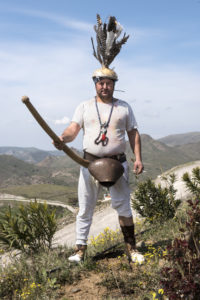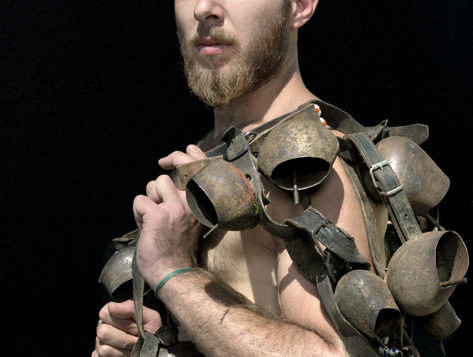MESOTOPOS is a typical little village of 950 souls on the western side of Lesbos, the Greek island that has been in the news a lot lately as a point of arrival for thousands of refugees and migrants entering Europe illegally from Turkey. The village is built amphitheatrically on a hill overlooking the Aegean, two miles from the coast and its translucent blue waters. Some say there has been a settlement on the site since prehistory. It should be noted that in antiquity Lesbos was home to many poets, including the great Sappho, as well as Alcaeus, Arion and Terpander.
In the past, the villagers, most of whom farm and raise stock, had close working ties with Smyrna (Izmir, Turkey) across the water. I’d say that most of the older inhabitants are barely literate and that, as a whole, they don’t have much to do with the big towns. They’re simple, hospitable, courteous people who enjoy living close to nature, and they remain devoted to their traditions, which they take pains to pass on to the younger generations.
For many years now—in fact, so many that no one can quite remember when it started—the village’s active Cultural Association has organized all manner of carnival activities on the last Sunday before Lent, including simple comic sketches and stand-up comedy in which the schoolchildren and younger villagers take part. These activities are a great opportunity for people to enjoy themselves and escape the daily drudgery for a while.
 The events culminate in the appearance of a group of men, most of them shepherds, each wearing dozens of bells in copper and iron of every size—the sort you’d normally find around the necks of sheep and goats. Altogether, the bells on any one man can weigh as much as twenty kilograms or more.
The events culminate in the appearance of a group of men, most of them shepherds, each wearing dozens of bells in copper and iron of every size—the sort you’d normally find around the necks of sheep and goats. Altogether, the bells on any one man can weigh as much as twenty kilograms or more.
Anonymous behind their black-daubed faces, these bell-wearers (or Koudounatoi, as they are called) act out their desires, their repressed and suppressed erotic instincts, as they seek to purify the community and scare away evil spirits with their apotropaic appearance and the loud, scary ringing of their bells. Others believe they symbolize the souls of the dead, which have the power to make the land fertile again.
They wear traditional headdresses, similar to the keffiyehs the Arabs wear, or a bright yellow and red hat that they make themselves by cutting a gourd in half and pinning a few turkey and cockerel tail feathers to the end. They hold a long, thick phallic staff (the koutskouda), with which they pound the earth, as though inviting Mother Nature to open up her dark womb for them to plant the seed with new life, or somehow seeking to release the light into the last, dark days of winter so that new growth can begin. This pagan ritual has deep, primordial roots with links to Dionysian worship and acts of faith with which the villagers hope to fertilize the earth by magical means.
One of the oldest of the bell-wearers is dressed in white long johns and has a phallus painted on his vest. He has a big bell dangling down below his belly, and the long crook he is holding ends in an extremely lifelike carving of a bulbous penis head. He is the Old Man (Yeros) or the Frontman (Brostaris) who leads the procession of Koudounatoi. The men wend their way through every street in Mesotopos with apotropaic human bells on display, downing the villagers’ offerings of wine and spirits while other villagers tauntingly chant: “Your good old schlong, make sure it’s long and strong.” When they finally work their way out to the village edge, intoxicated from the booze and their exertions, two men in the traditional island breeches (vrakes) dance the cavorting, unashamedly erotic “Arapiko” [“Arab-Negro” dance] with all its coy caprices.
Early on Sunday morning, the soon-to-be-bellmen arrive at the top end of the village in their pickup trucks with joy in their hearts and sacks full of bells in the back of the trucks, most of them fresh off their flocks. Some of their friends come along, too, to help them get ready. The atmosphere is as festive and jocular as the day demands, and the men are forever breaking out into laughter and song, teasing one another, then laughing some more. The sexual innuendo (mostly gay) and the alcohol flow freely.
There is no set way of getting the Koudounatoi ready. They usually start with the big bells on the arms and gradually add the rest until their entire bodies are covered. They leave the legs till last. Now, weighed down with bells and girded by leather straps, their movements are constrained. All the Koudounatoi can do is jump up and down on the spot and make a powerful din. If they stop moving, even for a few moments, their muscles freeze up under the weight, their bodies start to ache, so they have to twist their bodies vigorously to and fro and leap into the air to get the bells swinging hard, their impact providing a massage of sorts and some relief. Last of all, they blacken their faces and don their keffiyehs or gourd-hats.
 Around noon, when everyone is ready and in the finest of spirits, the Old Man takes his place at the front, pulling a patient donkey adorned with colorful fabrics and balloons behind him. Around sixty Koudounatoi set off after him in single file. Like the Bacchae of antiquity, helped by copious amounts of alcohol and their short, rhythmic steps, they gradually enter a state of ecstasy as they head for the village and their final destination: the Cultural Centre. As they start their descent, a booming, terrifying noise covers the village, as though supernatural forces are trying to pry open the earth, or a devastating earthquake is heading in their direction out of the depths. The lower down the hill they get, the louder and more distinct the sound becomes—until you think an angry flock of goats is entering the village.
Around noon, when everyone is ready and in the finest of spirits, the Old Man takes his place at the front, pulling a patient donkey adorned with colorful fabrics and balloons behind him. Around sixty Koudounatoi set off after him in single file. Like the Bacchae of antiquity, helped by copious amounts of alcohol and their short, rhythmic steps, they gradually enter a state of ecstasy as they head for the village and their final destination: the Cultural Centre. As they start their descent, a booming, terrifying noise covers the village, as though supernatural forces are trying to pry open the earth, or a devastating earthquake is heading in their direction out of the depths. The lower down the hill they get, the louder and more distinct the sound becomes—until you think an angry flock of goats is entering the village.
When the apotropaic procession finally enters the courtyard of the Cultural Centre to enthusiastic applause from the villagers, the Koudounatoi, sweating and on fire, release a final spate of terrifying noise before descending upon the buffet prepared by members of the Cultural Association. They’ll sample the local food and wine, then enjoy the music and dancing into the small hours. The celebrations continue on Clean Monday, the first day of Lent, at Tavari, the cove where the villagers winter their boats, with Lenten fare (seafood, octopus, sea urchins, scallops), gallons of ouzo, traditional music, and a special song written by a local poet in the Lesbos dialect hymning the coming spring, its trees in bud, the lengthening day, and the returning swallows.
Dimitris Yeros is a Greek artist and photo-grapher whose works have been widely shown in Europe and North America. His photos appear on these pages.





